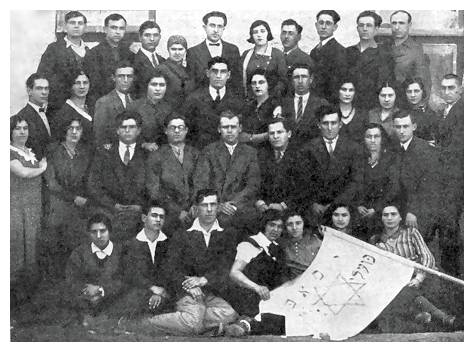 |
|
[Pages 70-72]
Translated by Jerrold Landau After the imposition of Romanian rule upon the population of Bessarabia (1918-1923) and the crushing of the communist fermentation, a more liberal spirit began to blow, with the desire to attract the community and to integrate it into the economic and
|
|
Members of “Poalei Zion”, “Haoved” and “Dror”
Upper Row from right to left: 1. Yaakov Kulik 2. … 3. Arye Balan 4. Likodrietz 5. Sima Fudman 6. Avraham Portnoy 7. Shteynshlager 8. Filarsky 9. S. Chananis 10. Buka Bozinyan |
The Jewish citizens began to get used to their new conditions. Business relations were forged between Moldova and Harghita, and children began to be sent to Romanian schools. The youth continued their studies in universities. Communal institutions began to participate with the Jews of Romania, and at times they were helped by them with regard to government institutions and with regard to forging civilian and political relations. For some of the Jews, it seemed as if the liberal rule of Romania would continue, and the Jewish population would become rooted from both an economic and national perspective, without disturbance.
However, most of the Jewish youth, along with many other strata of the progressive Jewish population, did not believe in these delusions. They rather believed in Zionism. The movement for aliya to the Land strengthened in Bessarabia, including Orheyev. A group of studying youth called “Bnei Yisrael” was organized in 1922-1923, with the objective of preparing themselves for the building up of the Land. In its wake, Gordonia and Hashomer Hatzair organizations were founded. These movements attracted primarily the studying youth. The Jewish workers, who were also not satisfied with life in the exile, did not find their place in their youth organizations. The desire for Zionist organization in the eyes of the workers, as well as their economic, professional and social needs, stood at the head of their worries. They were also concerned that the portion of the workers would not be ignored in the distribution of aliya permits.
|
Youth Group, “Poalei Zion”
At first, the meetings were arranged in secret on account of the ban on assembly. As time went on, members of the Zionist council in our city – Pagis, Dr. Berkovitz, and Y. Yagolnitzer – obtained permits for meeting places for the organizations of the Zionist movement, at first in the Yeshiva and later in various places in the city.
We broadened our activity in the meeting places. We established contact with the Poalei Zion headquarters in Warsaw, and received publicity material from them. Similarly, we established contact with the regional secretary in Chernovits, Chayim Geler (today a member of the active committee of the Histadrut). After that, we did not stumble in searching for a way. We were assisted at all times with material and direction for our activities. The agronomist Chayim Feigin of blessed memory also helped us significantly. He had a significant role in the establishment of the Poalei Zion party in Bessarabia in general and in Orheyev in particular.
The cradle of the Hechalutz (pioneers) of Poalei Zion in Romania was Orheyev. Tradesmen from among our members, including carpenters, locksmiths, drivers and tailors decided to prepare themselves for aliya to the Land.
The Hechalutz center in Kishinev was composed of representatives of Gordonia, Hashomer Hatzair and representatives of the Working Land of Israel. They were primarily concerned with strengthening the Hachsharah kibbutzim that was close to their spirit. Of course, they were not interested in nurturing a Hachsharah kibbutz that was not in accordance with their spirit. Any suggestion and request from our part to establish Hachsharah depots for Poalei Zion did not come to fruition. Therefore, we decided to set up a Hachsharah depot in Orheyev with our own initiative. We established contact with the estate owners in our region. After much toil and difficulty, we succeeded in establishing a Hachsharah depot in the vineyard of Moshe Vaynberg. Throughout the summer, we worked in the vineyard of the aforementioned, as well as in the nearby rock quarry and at various other agricultural pursuits.
|
|
Poalei Zion
Standing from right to left: 1. Sander Filarsky 2. Pinchas Erlikh 3. Chava Polinkovsky 4. Chaya Shaposhnik (Finkelshteyn) 5. Yaakov Vaynshteyn 6. Avraham Finkelshteyn 7. Moshe Fisher 8. … 9. Shaike Kantor 10. Y. Yochist 11. … |
|
JewishGen, Inc. makes no representations regarding the accuracy of
the translation. The reader may wish to refer to the original material
for verification.
JewishGen is not responsible for inaccuracies or omissions in the original work and cannot rewrite or edit the text to correct inaccuracies and/or omissions.
Our mission is to produce a translation of the original work and we cannot verify the accuracy of statements or alter facts cited.
 Orgeyev, Moldova
Orgeyev, Moldova
 Yizkor Book Project
Yizkor Book Project
 JewishGen Home Page
JewishGen Home Page
Copyright © 1999-2026 by JewishGen, Inc.
Updated 25 Jan 2006 by MGH